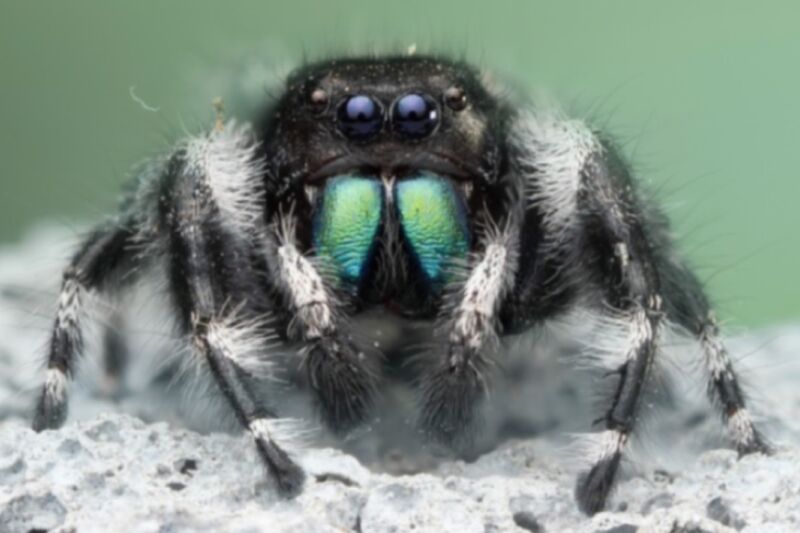

Inside the making of National Geographic’s A Real Bug’s Life docuseries
source link: https://arstechnica.com/science/2024/01/inside-the-making-of-national-geographics-a-real-bugs-life-docuseries/
Go to the source link to view the article. You can view the picture content, updated content and better typesetting reading experience. If the link is broken, please click the button below to view the snapshot at that time.

A different perspective —
Inside the making of National Geographic’s A Real Bug’s Life docuseries
Awkwafina tells their stories as various bugs struggle to survive in harsh habitats.
Jennifer Ouellette - 1/24/2024, 1:45 PM

Pixar's 1998 animated film A Bug's Life celebrated its 25th anniversary last year, and National Geographic decided to mark the occasion with a new science docuseries, A Real Bug's Life, narrated by Awkwafina. As with the Pixar film, the bugs (and adjacent creatures) are the main characters here, from cockroaches, monarch butterflies, and praying mantises to bees, spiders, and even hermit crabs. The 10 episodes tell their stories as they struggle to survive in their respective habitats, capturing entire ecosystems in the process: city streets, a farm, the rainforest, a Texas backyard, and the African savannah, for example.
The genesis for the docuseries lies in a rumored sequel to the original film. That inspired producer Bill Markham, among others, to pitch a documentary series on a real bug's life to National Geographic. "It was the quickest commission ever," Markham told Ars. "They said yes literally over a weekend. It was such a good idea, to film bugs in an entertaining family way with Pixar sensibilities." And thanks to the advent of new technologies, plus a couple of skilled "bug wranglers," the team captured the bug's-eye view of the world beautifully.
According to Director of Photography Nathan Small, long tube-like probe lenses enabled the camera crew to capture footage from inside tiny cracks and holes to better document the buggy behavior. They also made better use of macro lenses. "Before when we had macro lenses, they were all quite long, and the background would be really smooshy with everything out of focus," Small told Ars. "We tried to shoot everything from very low, very wide angles with lots of context, so you can experience the world from the point of view of the animal and see how it sits in its location, rather than just a smooshy background."
The shoots required camera operators to lie on their bellies a lot to capture that view, and doing so on the streets of New York City or a farmyard wasn't always pleasant. But the team was also able to rely on custom-made robotics operated remotely with PlayStation controllers, which had the added benefit of producing very smooth and precise footage free of the kind of camera wobbles that can become magnified at such tiny scales.
Advertisement-
An American cockroach in all its spindly glory.
-
Director of Photography Alex Jones films army ants and an elephant beetle in Costa Rica.
-
Bug wrangler Tim Cockerill on a shoot in the Costa Rican rainforest.
-
An orchid bee in flight.
-
A buff tailed bumblebee with its proboscis out on a green plant.
-
Fire ants gather inside an electrical box in a Texas backyard.
The crew's dedication to getting the best footage is evidenced by Small's six-month mission to capture the hatching of cockroach egg casings—one of the many firsts caught on camera for the series. After several failed attempts, Small bought an egg incubation system and set it up in his spare bedroom. (He credits his "very patient" wife with allowing the experiment.) "I had to build a special moat system if they hatched so they wouldn't escape because the last thing you want in your private residence is a cockroach infestation," he said. Once a week, Markham would check in to see if the casings had hatched yet. The blessed event finally took place at 3 am one morning, and Small got his footage of the tiny translucent creatures emerging from the casings.
Also key to getting those one-of-a-kind shots: insect wranglers like zoologist Tim Cockerill, who got involved with TV science programs while working on his PhD. (Cockerill has worked at circus sideshows as a fire eater and created his own flea circus, so he caught the entertainment bug early.) Every insect poses different challenges, but Cockerill told Ars that wrangling the army ants on location in the Costa Rican rainforest was probably the trickiest. It's an easier task to manipulate the ants on a film set, but the whole point of A Real Bug's Life is to capture natural behavior.
"You've got a colony of large army ants, literally hundreds of thousands with a very nasty bite, moving from one place to another and doing their own thing," he said. "You can't make them do anything they don't want to do." It becomes crucially important to set up the cameras' lighting, and so forth, in such a way that the natural behavior can emerge, while also protecting the crew. "It's very difficult with lots of bites and shouting and swearing, but it's worth it in the end," said Cockerill.
Page:
Recommend
About Joyk
Aggregate valuable and interesting links.
Joyk means Joy of geeK